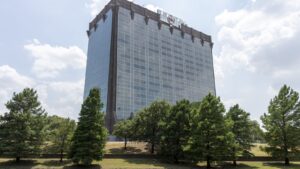This was another dynamic year for the health care industry and for health care real estate, which is demonstrating remarkable resiliency and innovative success in the face of unprecedented challenges.
Below is a summary of a number of key 2021 takeaways and trends that were discussed during our 2021 Health Care Real Estate Year in Review webinar, now available on our podcast channel by clicking here.
Academic Medical Centers
Academic medical centers (“AMCs”) (or health systems affiliated with an AMC) continued to lead large-scale “destination” medical center development projects in 2021. Several multi-billion-dollar projects anchored by AMCs were either announced or broke ground this year in regions across the country. The projects include a range of uses, including new outpatient clinics, ambulatory surgery centers, inpatient hospital expansions and, in some cases, non-medical uses such as housing and fitness facilities. The health care campus of the future is here!
Ambulatory Surgery Centers
Ambulatory surgery centers (“ASCs”) have come into their own with many of the major health systems looking to acquire or form partnerships with ASC owners and operators. This is driven, in part, by payors and patients demanding that more surgical services be provided in lower acuity settings. In 2021, over 200 new ASCs were opened or announced according to Becker’s ASC Review. Florida, Arizona, New York, Texas, Pennsylvania and Michigan topped the list with the most new announcements. In other ASC news, the trend towards convergence of payor, provider and operator continues. A number of for-profit payors and providers have gone on ASC buying sprees this year.
Supply Chain And Labor Shortages
Supply chain disruptions and labor shortages are tempering the pace of health care construction. The staffing, supply and hospital-bed shortages that health care providers and real estate developers hoped were temporary now appear to be longer-term challenges that will reshape hospital real estate and development projects well into 2022. The construction industry is not immune to labor disruptions triggered by ongoing COVID-19 challenges, which is resulting in delays for new hospital and development projects as contractors work to find qualified workers. By one estimate, contractors will need to hire 430,000 more employees in 2022 and 1 million more in the next two years to keep up with the increased project demand. If contractors do not meet those metrics, health systems should expect and plan for delays to their upcoming projects.
Construction industry supply chain challenges, like labor shortages, will continue to impact hospital projects heading into next year. Although demand for new projects continues to be strong, supply chain issues are causing health systems and developers to approach delivery timelines and project cost estimates with an added level of caution. Some of the major general contractors are shifting the risk of delays and cost overruns for supply chain issues to owners and developers. In response to ongoing supply chain challenges, some health systems have begun evaluating the use of a centralized service model using a Consolidated Service Center (“CSC”) to manage certain supply chain needs. Although typically evaluated in the context of operational supply chain needs, the CSC model could be evaluated in the context of facilities planning, as well.
Certificate Of Need Programs
In the wake of the COVID-19 pandemic, with many hospitals at or nearing capacity, many states have either relaxed or suspended certificate of need (“CON”) requirements, triggering significant new facility announcements. In Florida, for example, over $1 billion of new facilities have been announced in the last quarter of this year.
Telehealth
At the height of the pandemic, some experts claimed the physician office visit would be a thing of the past. Now, over a year later, we see telehealth stabilized nearly four times higher than pre-COVID, but not replacing the office visit. Telehealth visits appear to have stabilized at a range of 13% to 17% of visits across all specialties. The specialties experiencing the highest growth in telehealth usage include psychiatry and substance-use treatment. Consumer demand for virtual care solutions, however, continues to be strong. According to an AHA report, between 40% and 60% of consumers want more virtual care solutions, such as a “digital front door” or lower-cost virtual health plans. That said, the regulatory and reimbursement environment for telehealth remains uncertain, giving reason to temper growth predictions for the immediate future.
Hospital-Based Property Tax Exemptions And Government Intervention
Local government is continuing to take aim at nonprofit hospitals and health systems with respect to property tax exemptions and other real estate-related issues. In a widely watched case, a trial court decision in Pennsylvania ruled that three nonprofit hospitals were not tax‑exempt charities entitled to property tax exemption. The ruling has triggered local governments and school districts around the state to reconsider health care- and hospital-based property tax exemptions. In another closely watched governmental action, the State of New Jersey has proposed legislation that would require state approval for the termination of a hospital lease. The legislation, although aimed at one particular hospital, raises interesting issues of governmental authority, and legislation of this type could have far-reaching impacts.
Regulatory Matters
Qui Tam Lawsuits – Litigation under the False Claims Act has been on an uptick under the Biden Administration. The year 2020 saw the largest number of new matters initiated in a single year; and, although year-end numbers have not been released yet for fiscal year 2021, we expect to see that trend continue upwards. OIG self-disclosure settlement data indicates that remuneration and fair market value, together, represent nearly 70% of all cases. Settlement figures continue to be significant, ranging in recent years from $4 million for office leases not complying with the Stark Law up to $93.5 million for a hospital offering free office space to a physician group.
CMS Vaccine Mandate – On November 4, 2021, CMS released its Interim Final Rule (“IFR”) requiring COVID-19 vaccinations for individuals working in Medicare and Medicaid participating facilities, as well as individuals working in certain other settings involving face-to-face interactions with patients. The IFR effective date was December 5, 2021; however, legal challenges have enjoined enforcement in many states. Most recently, in an unprecedented move, the U.S. Supreme Court announced it will hear oral argument on an emergency application on January 7, 2022. The court’s order to hear oral argument on the issue demonstrates the perceived legal and practical importance of the federal government’s IFR.
Health Care Real Estate – Capital Trends
Historically low interest rates for taxable and tax-exempt debt continue to give hospitals and health systems flexibility in financing capital projects. Hospitals are seeing historically low rent factors and, increasingly, are taking more direct financial control of their real estate assets through direct placements and non-traditional financing mechanisms. Capital competition for core, quality, hospital-sponsored medical office buildings continues to be strong in light of supply-side shortages. On the other hand, skilled nursing and senior housing projects are facing a different set of challenges in terms of sourcing equity and debt. In a recent survey from Hilltop Securities, investors expressed the most concern with senior housing and skilled nursing sectors when compared to other industry sectors. This means investors and lenders will continue to take a more conservative approach to underwriting senior housing and skilled nursing projects heading into 2022.
Medical Office Buildings
The Medical Office Building (“MOB”) continues to demonstrate resiliency relative to other asset classes. Based on trading earlier this year, we expect final 2021 figures to show MOB sales volume having bounced back to pre-pandemic or near pre-pandemic levels, especially in sunbelt markets. As health care continues its shift away from inpatient care models, and as the traditional (non-medical) commercial office market continues to experience uncertainty, demand for MOB investment is predicted to remain strong.
Life Sciences
Over the last 18 months, governmental entities and private investors have pumped billions of dollars into the life sciences industry. A CBRE report found investments from venture capital into the life sciences industry last year totaled a record-breaking $17.8 billion through the second quarter of 2020 and anticipated funding from the National Institutes of Health to grow 6% from the prior year ($42 billion total). As a result, the demand for real estate to support that uptick in life sciences work also increased. The amount of laboratory space grew by 12% in 2020, with 95 million square feet of laboratory space in the United States and another 11 million under construction. It makes sense, therefore, that one recent market survey ranked life sciences and biotech as the best risk-adjusted health care real estate opportunity, significantly outperforming medical office buildings and senior housing. Because COVID-19 testing is widely available and vaccine availability is increasing, capital investment for research and development related to COVID-19 and other infectious diseases is likely to continue. As a result, the demand for real estate to support that research and development should also continue.
Medtail
Medtail — a relatively new term referring to the combination of medical and retail — has continued to gain traction this year. As health care consumers continue to seek convenience care options, expect the medtail trend to continue. In 2021, discount retailer Dollar General joined other retail giants like Walgreens and CVS when it announced the hiring of its first chief medical officer who will be tasked with expanding affordable health care services through Dollar General stores, especially those in rural communities.
Senior Housing
After a difficult two years, experts are predicting increased investment activity in this sector in 2022, even with forecasted occupancy levels not reaching pre-pandemic levels until late 2022. Senior Housing News estimates by 2029, there will be 14.4 million middle-income seniors. Providing affordable senior housing will continue to be one of the biggest opportunities and challenges, as 54% of the middle-income seniors will lack resources to pay market senior housing rates according to the same Senior Housing News report. Expect the post-pandemic changes to the senior housing industry to include:
• Hiring new clinical staff and bolstering on-site clinical services offered at senior housing locations;
• Expanding telehealth options for residents to reduce travel to off-site inpatient and outpatient facilities;
• Permanently installing and implementing disease and infection prevention policies and procedures to control future outbreaks; and
• Focusing on active living communities to better balance socialization and privacy, thereby avoiding the isolation many residents experienced during the pandemic.
The COVID-19 pandemic will not only affect the construction and operation of senior housing, but also the location of these facilities. During the pandemic, millions of people moved from large urban areas to less populated locations in middle and smaller markets around the nation. Many of these markets offer a lower cost of living and a warmer climate that may attract aging populations as compared to more densely populated areas. As a result, expect more development in those markets to align with the aging population’s migration trends.
Finally, a number of senior housing developers have started to offer “ultra luxury” senior housing products in certain markets. These facilities often include private chefs, personal butlers and premium design features and are targeting elite members with monthly fees up to $20,000 on top of entrance fees of $200,000.
Skilled Nursing Facilities
Despite a difficult two years and ongoing operational challenges, Skilled Nursing Facilities (“SNFs”) could see some modest relief in 2022; although, it is likely to remain a challenging environment for the near term. Earlier this year, it was announced that nursing homes would receive a 1.2% net Medicare increase for fiscal year 2022 under a proposal announced by CMS, which would result in an estimated $410 million much‑needed financial boost to SNF operators. According to the final rule, due to the ongoing public health emergency, CMS will also suppress the SNF 30-day all cause readmission measure for the FY 2022 value-based purchasing program year.
Social Determinants Of Health; Housing Is Health Care
Social Determinants of Health (“SDOH”) continue to gain traction with hospitals and health care providers. Last year, we reported on focus areas addressing homelessness and affordable housing, with some providers emphasizing “housing is health care.” We saw that momentum continue this year, with a number of major health care-anchored housing investments around the country. At this year’s HLTH 2021 Conference, executives from several major health systems highlighted affordable housing as a key health care intervention strategy. As a relatively flexible and tangible community benefits investment strategy, affordable housing is increasingly popular with hospitals and health systems. The early data on these programs show promising results. A March 2021 analysis of one hospital system’s affordable housing program, which includes over 800 affordable housing units, found a social return between $1.30 and $1.92 for every dollar spent operating those units. There is still a dearth of research about the social and economic returns of affordable housing and other social determinants programs, but expect more providers to invest in these types of programs if future data supports results like the March 2021 study. At the federal level, the Aligning for Health Consortium was successful introducing the Social Determinants Accelerator Act of 2021, a bipartisan bill designed to help states and communities develop strategies to better address SDOH and improve health outcomes.
Source: Lexology








